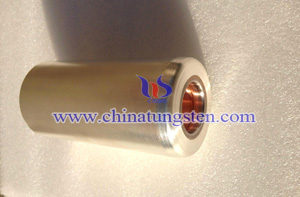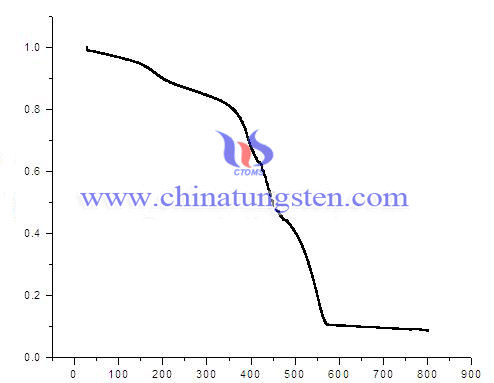Tungsten Copper with Gradient Structure (2/2)
- Details
- Category: Tungsten Information
- Published on Tuesday, 16 February 2016 17:15
- Written by xiaobin
- Hits: 235
For the manufacturing process of the gradient structure tungsten-copper composite materials, researchers and scholars in related fields, and also made a variety of attempts to conceive. Here is a brief introduction to several related new technologies, such as conventional dry lamination method, hierarchical load a different size of tungsten powder, cold pressed, sintered, after copper infiltration preparing different graded material consisting of tungsten-copper ( good sintered porous tungsten skeleton electrochemical corrosion formed along the direction of tungsten skeleton having a gradient porosity by infiltration of copper can be obtained having a continuous change in the composition of tungsten copper gradient material); the other one uses hot isostatic pressing diffusion bonding to form tungsten copper with gradient structure by different contents.
In addition, another type is prepared by continuous gradient layer, such as slip casting, sedimentation molding, centrifugal molding, etc. Plasma spraying is a kind of new method that are compacting and sintering tungsten copper powder with different content. There are two methods which have already patented process, one is the use of powder metallurgy - infiltration process. Preparation of powder metallurgy method which utilizes two components completely different copper tungsten compact, then where the thermal conductivity of tungsten copper larger compact embedded in another compact, due to the embedding of relatively high copper content briquette making its thermal conductivity is relatively high, and has a lower peripheral compact copper content, thus ensuring the overall coefficient of thermal expansion gradient material decreases. Another one is that combines tungsten copper (W-Cu) with ceramic based on aluminum nitride-aluminum (AlN-Al), ceramic has a gradient structure with a metal having a thermal expansion coefficient due to the match, so the lower internal stress, and as part of a combination of metal and ceramic high thermal conductivity such that heat will not affect the heat concentrated in the buffer layer and the heat radiating effect of the heat sink materials.
| Tungsten Copper Supplier: Chinatungsten Online tungsten-copper.com | Tel.: 86 592 5129696; Fax: 86 592 5129797;Email:sales@chinatungsten.com |
| Tungsten News & Prices, 3G Version: http://3g.chinatungsten.com | Molybdenum News & Molybdenum Price: http://news.molybdenum.com.cn |
Tungsten Copper with Gradient Structure (1/2)
- Details
- Category: Tungsten Information
- Published on Tuesday, 16 February 2016 17:13
- Written by xiaobin
- Hits: 242
Tungsten copper (W-Cu) and molybdenum copper (Mo-Cu) are composed of respectively tungsten and molybdenum with copper, which called two-phase composites and has many advantages when it used in some devices with high power, such as high hardness, high strength, high melting point, excellent chemical stability, excellent thermal and electrical conductivity and lower coefficient of thermal expansion. As a kind of electronic packaging heat sink material takes place of conventional materials gradually, the related researchers make an intensive study on tungsten copper, which includes add active agents, change powder properties to improve the sintering density of tungsten copper materials.
However, the conditions of some industries today have become more and more strict (including temperature, pressure, power, etc.), which requires tungsten copper has better properties. Inspired by tungsten carbide with gradient structure, the Japanese researcher propose new concept of functional materials with gradient structure and from the preparation process structure, computer simulation and forecasting has done sufficient research, have also made substantial progress, so that it plays an important role in some high-power devices. Tungsten copper composite material is kind of two-phase psudoalloy, which composed of two metals tungsten and copper with a great difference in physicochemical properties.
Its properties will change with the structure. Viewed from the aspect of gradient structure, it can has one end with a high hardness, high melting point, tungsten or copper content is low high-density tungsten copper, while the other end is a good electrical and thermal conductivity and high plasticity of copper or copper content of tungsten, copper, in this way the formation of gradient structure having a tungsten-copper composite materials have a good specificity and a broader application prospect.

| Tungsten Copper Supplier: Chinatungsten Online tungsten-copper.com | Tel.: 86 592 5129696; Fax: 86 592 5129797;Email:sales@chinatungsten.com |
| Tungsten News & Prices, 3G Version: http://3g.chinatungsten.com | Molybdenum News & Molybdenum Price: http://news.molybdenum.com.cn |
Preparation for NOx Series Catalyst with Selective Catalytic Reduction at High Temperature
- Details
- Category: Tungsten Information
- Published on Tuesday, 16 February 2016 16:16
- Written by chunyan
- Hits: 240
When the temperature of waste gas is higher than 500℃, Vanadium catalyst directly oxidation of NH3is significantly enhanced, resulting in a significant reduction in the removal rate of NOx. Under high temperature, the WO3-TiO2 system has better catalytic activity and high temperature stability compared to the traditional V205-W03/TiA system. A method for preparing WO3-TiO2 catalyst is described in this paper, steps are as follows:
1. Mixing ethanol, tetrabutyl titanate and glacial acetic acid by volume ratio 2:1:1, get solution A;
2. Dissolve ammonium paratungstate in the oxalic acid solution with mass concentration of 5% to obtain solution B, in which the mass ratio of ammonium paratungstate: oxalic acid is 1.6:1;
3. Drop a certain amount of solution B into solution A slowly, in which the quality ratio of ammonium paratungstate and tetrabutyl titanate is 0.029:1~0.11:1, stirring constantly to form a uniform and stable sol;
4. Static settling for 40~60 hours, dry in an oven at the temperature of 50~ 60℃ for 16~30 hours to get a dry gel;
5. Grind the dry gel in a mortar for 30~50 minutes, then calcine in the muffle furnace at 550~650 ℃ for 3~6 hours, get the high temperature SCR catalyst WO3-TiO2 with the active component WO3.
The catalyst in this paper has the advantages like: simple process and low production cost, with high active at the temperature of 450~550℃, higher denitrification rate, long service life, high thermal stability.
| APT Supplier: Chinatungsten Online ammonium-paratungstate.com | Tel.: 86 592 5129696; Fax: 86 592 5129797;Email:sales@chinatungsten.com |
| Tungsten News&Tungsten Prices, 3G Version: http://3g.chinatungsten.com | Molybdenum News & Molybdenum Price: http://news.molybdenum.com.cn |
Regeneration Solution of SCR Denitration Catalyst
- Details
- Category: Tungsten Information
- Published on Tuesday, 16 February 2016 16:20
- Written by chunyan
- Hits: 237
 More than 90% of the thermal power plants deal with the flue gas denitrification using SCR which is short for Selective Catalytic Reduction, making SCR process widely use. The cleaning and regeneration of the catalyst is not only one of the effective methods to reduce the running cost of flue gas, but also can reduce the environmental pollution caused by solid waste. This paper introduces a kind of Regeneration Solution of SCR Denitration Catalyst.
More than 90% of the thermal power plants deal with the flue gas denitrification using SCR which is short for Selective Catalytic Reduction, making SCR process widely use. The cleaning and regeneration of the catalyst is not only one of the effective methods to reduce the running cost of flue gas, but also can reduce the environmental pollution caused by solid waste. This paper introduces a kind of Regeneration Solution of SCR Denitration Catalyst.
The components of it are as follows: Penetration enhancer (JFC) takes the 1‰~5wt‰ of total content, surfactant take 1‰~5wt‰, peregal take 0~5wt‰, ammonium metavanadate take 1%~4wt%, ammonium paratungstate take 6%~12wt% and ammonium molybdate take 2~6wt%, distilled water and acid take the remained contents.
The acid is the role of adjusting pH value in range 5~7, can be anyone of citric, oxalic and acetic acid.
The advantages of Regeneration Solution of SCR Denitration Catalyst are as follows:
1. Make-up active ingredients by the time cleaning denitration catalyst, which can significantly improve the activity of deactivation, and recover the activity as high as 90~105%;
2. Nonionic surfactant added in the regeneration solution not only improves the cleaning ability of catalyst, but also cause no damage to the catalyst carrier and other active components;
3. Catalysts after regeneration can be completely normal used making the service life reach more than 95% as the new catalyst.
| APT Supplier: Chinatungsten Online ammonium-paratungstate.com | Tel.: 86 592 5129696; Fax: 86 592 5129797;Email:sales@chinatungsten.com |
| Tungsten News&Tungsten Prices, 3G Version: http://3g.chinatungsten.com | Molybdenum News & Molybdenum Price: http://news.molybdenum.com.cn |
Tungsten Trioxide Complex Characterization
- Details
- Category: Tungsten Information
- Published on Tuesday, 16 February 2016 15:24
- Written by qiongyao
- Hits: 297
 TG (Thermal Gravity Analysis) is a term of thermodynamics, called thermal gravimetric analysis. Its meaning is: The sample in the specified temperature curve (rate), the rate decreases with its weight / ratio analysis. From the curve we can know the weight of sample reducing at certain temperature, and then it shows that the decomposition temperature of the sample at this occurrence (or other chemical reactions) is the most severe. TG Category 1, static method (isothermal): sample at a constant temperature, known as the "constant weight loss." TG Category 2, the dynamic method (temperature method): the sample under constant temperature, known as "TGA curve."
TG (Thermal Gravity Analysis) is a term of thermodynamics, called thermal gravimetric analysis. Its meaning is: The sample in the specified temperature curve (rate), the rate decreases with its weight / ratio analysis. From the curve we can know the weight of sample reducing at certain temperature, and then it shows that the decomposition temperature of the sample at this occurrence (or other chemical reactions) is the most severe. TG Category 1, static method (isothermal): sample at a constant temperature, known as the "constant weight loss." TG Category 2, the dynamic method (temperature method): the sample under constant temperature, known as "TGA curve."
During the inspection process, the first steep, placing synthetic product in a muffle furnace, burning it 3h at 400 ℃ to obtain the tungsten trioxide powder samples of different doping amount of tungsten trioxide, and then getting the results via TG at FIG 50-400 ℃, characterizing it by the percentage change to determine the tungsten trioxide complex. From the TG graph , we can see when the temperature reaches at 350 ℃ , TG curve is approximately straight line, which indicates that synthesis product is lost when the temperature is about 350 ℃ . Weight of the synthetic product constantly decreases with temperature increasing.
Next, the synthesized product was characterized by X-ray powder diffraction analysis, the diffraction peaks can be found in standard synthetic products that were monoclinic phase product coincide, and there are not impurity peaks, which show the composite tungsten oxide does not cause polymorphs variety. In summary, the tungsten trioxide complex becomes into the admixture does not have a change in crystal form molybdenum trioxide.
| Tungsten Oxide Supplier: Chinatungsten Online www.tungsten-oxide.com | Tel.: 86 592 5129696; Fax: 86 592 5129797;Email:sales@chinatungsten.com |
| Tungsten News & Prices, 3G Version: http://3g.chinatungsten.com | Molybdenum News & Molybdenum Price: http://news.molybdenum.com.cn |





 sales@chinatungsten.com
sales@chinatungsten.com